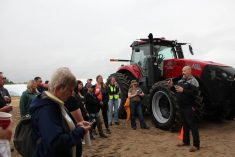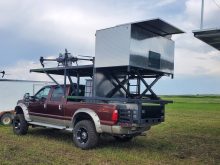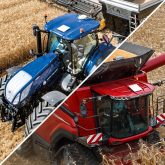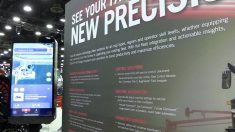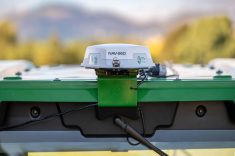Matt Vossepoel bought his first drone, a DJI Mavic 2 with a thermal camera, two years ago so he could check on his 800-head of cattle and find sick animals or animals he couldn’t always see easily due to the terrain of his farm. Before long, he was using it during calving to check for lone calves or cows having difficulty giving birth.
Time savings, decision-making assistance, prescription map creation and use as a calving aid are the most important advantages of drone technology on their farms, say farmers.
Read Also

Claas brings 1000 Series SP forage harvesters to Canada
In mid-August, Claas unveiled its new line of Jaguar forage harvesters at an event in Visalia, California, deep in the heart of that state’s dairy region.
Last spring, he upgraded to a Mavic 2 Zoom model, which also has a zoom function, so he can get pictures from higher up and not risk spooking young calves by flying too low.
“It has cut down my travel time for checking the cows,” he says. “In the spring and at seeding time, farmers can never have enough time, so if I can go and check 800-head of cows in 10 minutes and get a rough understanding of where everything is, as opposed to spending 20 minutes checking each field, there is value there in just the time savings alone, and then also the early detection for problem calvers. It has helped me so much.”
Vossepoel, who farms near Tilley, Alta., is impressed with the resolution of the camera on his current drone, which has 4K video and 1080-pixel pictures. He has used it to identify drowned out areas of fields and for checking his feed corn for missed spray areas and heavy weed infestations.
To date, he has invested around $10,000 in his two drones, the software and an iPad, but it’s also an investment that brings value to his community as well as his farm because as a volunteer firefighter he has used it to help train new recruits.
Cautious approach to drone technology
MacKenzie Johnston farms between Pennant and Cabri in southwest Saskatchewan and for three growing seasons he has used his DJI Phantom 4 PRO drone system, which features an infrared camera.
Johnston says the drone aids in decision-making and he admits he never likes to just rely on a new technology before it’s proven itself on his farm. However, gradually, over the years, he has become more comfortable and confident in the data the drone provides.

In 2019, as an example, because conditions were very dry, he used the drone to help assess which fields could benefit from a fungicide application. “We used the drone to create a NDVI (normalized difference vegetation index) map and in conjunction with our sprayer cab app, which provides real-time mapping of our equipment, I was able to upload that NVDI map onto our iPad and manually turn the sprayer on and off,” says Johnston.
“I would look at the map our drone had made and as I was driving I would get to a spot where it might suggest turning the sprayer nozzle off and could visually confirm that the map was right.”
After comparing his actual application map with the NDVI map later, Johnston says he probably would have been comfortable if he had generated and followed a prescription map from the drone data. “If we’d had a similar situation this year, I would likely have used those NDVI maps to make prescription maps instead of manually turning the sprayer on and off,” he says.
Confident decisions
Last year, Johnston found the drone useful for determining the maturity of crops, and whether they were ready for a pre-harvest herbicide application. It definitely saved him some time and money when it came to spraying kochia in a canola field that was hard to access.
“I was able to identify and spray areas of kochia around the edge and a couple of sloughs, so instead of spraying 400 acres, I sprayed about 40 acres. After I cut the canola, I was happy with that decision,” he says.
While Johnston says time savings and reduction of some inputs are definitely benefits to drone technology, being able to make more confident decisions will likely add a lot of value to the farm in years ahead. “I am not sure how you quantify that but it takes some of the guesswork out of it, and removes some of the stress of making decisions without having as much information as you would like,” he says.





